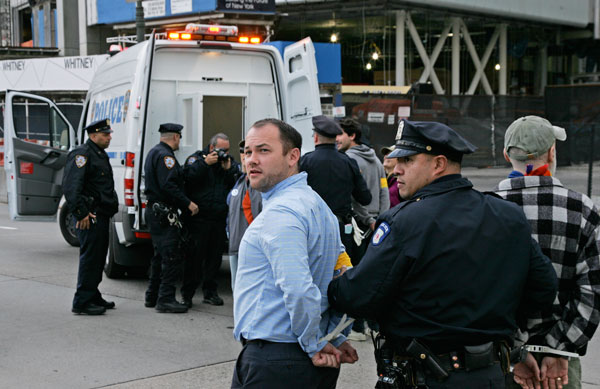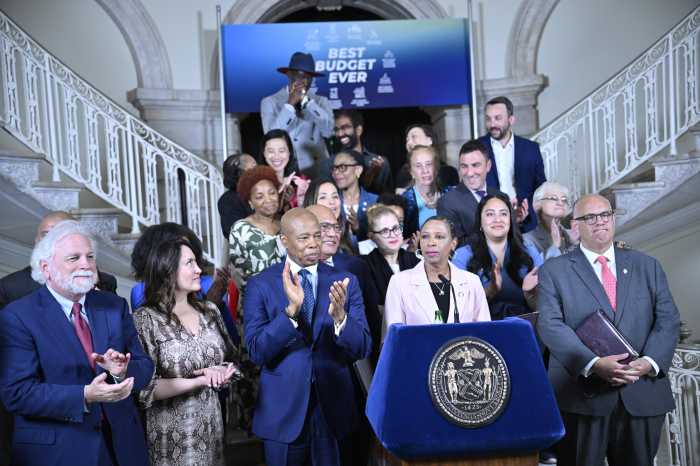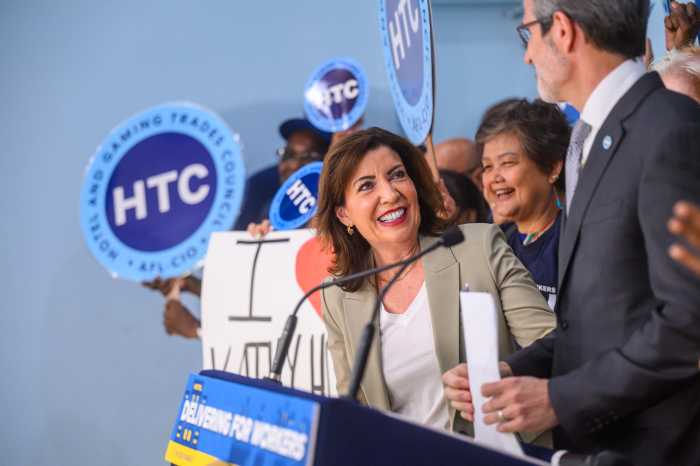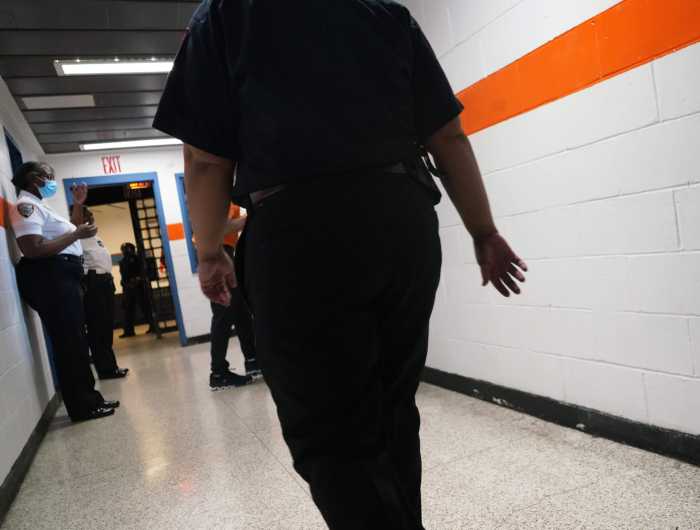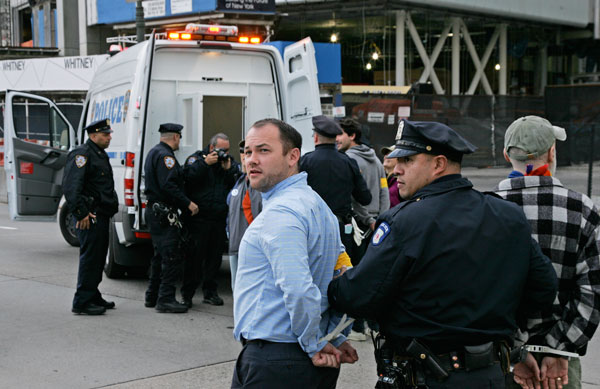
BY EILEEN STUKANE | Today, it’s all quiet on Gansevoort Peninsula where the Spectra Energy pipeline came ashore in 2013 after having been constructed under the Hudson River from Jersey City.
But a couple of years ago there was a lot of noise from Sane Energy Project activists, community leaders and Greenwich Villagers, who rallied here to block the new 30-inch high-pressure natural gas pipeline from operating.
Possible safety risks of leakage and even explosion, the chance of the gas containing elevated cancer-causing radon levels, and the city’s greater dependence on a hydraulically fractured — hydrofracked — fossil fuel, brought protesters to the Hudson River Park at Gansevoort St. for protests.
City Councilmember Corey Johnson, who was only a candidate at the time, was arrested with others for blocking the West Side Highway during a November 2013 demonstration.
In addition, Sane Energy Project and other environmental groups jointly sued the Hudson River Park Trust for granting Spectra an easement and a 30-year lease to allow its pipeline on Gansevoort Peninsula for a nonpark use, which they charged was not in compliance with the New York State’s Environmental Quality Review Act. But the suit was dismissed.
The Spectra pipeline became operational in November 2013. It terminates at an underground vault — basically a connecting station to Con Edison’s local system of gas mains — adjacent to the basement of the new Whitney Museum. A cantilevered section of the new Renzo Piano-designed museum casts its shadow over the spot.
Meanwhile, the community — which had once taken to the streets to protest the pipeline — turned its attention elsewhere.
Clare Donohue, program director of Sane Energy Project,
“At this point, there isn’t anything more we can do,” she said. “Our lawsuits were dismissed. The pipelines go in and everybody forgets them.”
Since pipelines have exploded so often, there is an entire Wikipedia page entitled “List of pipeline accidents in the United States in the 21st Century.”
Donohue worries about the underground vault being so close to the Whitney’s basement.
“The vault is where the Spectra pipeline connects with the Con Ed pipes, and anywhere that pipes connect is the most delicate place — the place most likely to leak and have a problem,” she noted. “And pipelines create more problems as they get older.”
In response to questions about the new pipeline’s safety, Marylee Hanley, Spectra’s director of stakeholder outreach, said there is nothing to worry about.
“The NJ-NY Expansion Project [the pipeline to the Village] transports safe, reliable, domestic supplies of natural gas to heat homes and businesses in the area,” she wrote in an e-mail. “The facilities were designed and constructed — and are operated and maintained — to be the safest pipelines in the nation. Monitored 24 hours a day, seven days a week, the facilities meet or exceed all federal safety standards and regulations.”
Although the Con Ed connection is made at the Gansevoort vault, Con Ed does not inspect the vault since, according to a spokesperson, “It is the property of Spectra Energy.”
“Spectra Energy personnel conduct a daily ground patrol and daily physical inspection of the NJ-NY Expansion Project pipeline facilities, 365 days a year,” Hanley added.
As for the Whitney’s view of the pipeline’s safety, a member of the communications department there said they are trusting that the appropriate government agencies will stay on top of it.
“While the natural gas pipeline does not cross directly onto the museum’s property, we followed the progress of the work because of its close proximity to the site,” the spokesperson said. “Governmental regulators, who oversaw and monitored the pipeline’s construction, are responsible for ensuring that the pipeline’s ongoing operation meets all applicable standards and requirements.”
The vault’s location, however, has not escaped the notice of the activist group Occupy Museums.
“We are concerned with the roles of museums in facilitating these kinds of infrastructure,” said the group’s Tal Beery. “We’re concerned with the vault because there’s no 100 percent guarantee of its safety.”
The Trust, which leased part of the park’s land to allow Spectra Energy to bury its pipeline in a shallow trench under Gansevoort Peninsula, did not respond to a question regarding the pipeline’s ongoing safety. Local parents have expressed worry that the Jane St. Pier with its children’s playground is within the pipeline’s potential “blast zone.”
In addition, there is the question of radon. A tasteless, odorless, colorless gas, radon is present in natural gas, and can be cancer-causing if inhaled regularly at unsafe levels. In fact, it is the leading cause of lung cancer among nonsmokers, and second leading cause among smokers.
Initially, anti-fracking activists feared that the radon in the natural gas traveling through the Spectra pipeline was going to exceed safety levels. The Environmental Protection Agency considers 4 picocuries per liter (pCi/l) as a safe level inside homes. The World Health Organization cites a lower 2.7 pCi/l as safe.
However, that prediction was based on the assumption that most of the pipeline’s gas would have come from hydrofracking in the Marcellus Shale in New York State, and that this gas would have taken only 12 hours to arrive in New York City, as opposed to the usual six to eight days it takes for Gulf Coast gas to reach the city.
In hydrofracking, underground shale rock is fractured — blasted open under high pressure with tons of water and sand laced with a slew of unspecified chemicals — which releases natural gas, but also disturbs the shale’s uranium and radium-226. In short, fracked gas contains radioactive radon. Radioactive radon has a relatively short half-life of 3.8 days, after which its concentration drops in half. After another 3.8 days, that half divides in half again, so it’s a fourth of the original’s strength, and so on. Hence, the longer the travel time, the more the radon dissipates and reaches safer levels.
However, Governor Andrew Cuomo’s ban on hydrofracking in New York State meant that concern that a substantial amount of the gas in the Spectra pipeline would originate nearby and have a short travel time would be alleviated.
Gulf Coast gas — more distant and thus safer for New Yorkers in terms of radon levels — was always going to be mixed in, and would compensate for the lack of fracked gas from New York.
For the last three winters, Sane Energy Project conducted citizen radon tests. The organization made 200 test kits available and asked volunteers to test for radon in their New York City homes. The results of this admittedly unscientific testing in 500 to 600 homes showed overall radon levels to be within the E.P.A.’s accepted safe range. Sane would like to raise funds to support a formal study.
A future governor could decide to lift the state’s hydrofracking ban. But advocates hope that, as a safeguard, legislation requiring the monitoring of radon in natural gas arriving at the city will be approved.
Upper West Side Assemblymember Linda Rosenthal has introduced legislation that would require gas corporations continuously to monitor the radon level in their gas deliveries. Radon levels should not exceed 2.7 pCi/l, and if they do, the bill states that the commissioner of the state Department of Health can order the gas flow stopped and a fine of $25,000 a day imposed on the corporations until radon levels are in compliance.
Rosenthal’s bill has passed in the Assembly but still requires passage by the State Senate, where its co-sponsor is Senator Diane Savino.
“The governor’s decision not to allow fracking is not a legal ban,” Rosenthal explained. “The radon level still needs to be measured and it’s something that the utilities are very opposed to. This bill has specific instructions on where to monitor, how often, and it’s not at the whim of the operator.”
During his tenure, former Mayor Michael Bloomberg mandated that building boilers be converted to natural gas.
“Mayor Bloomberg really set the city up for a gas infrastructure before he left,” said Sane’s Donohue, who notes that the current administration is taking a different approach.
“After the Climate March, Mayor de Blasio announced a plan to reduce the city’s greenhouse gas emissions 80 percent by 2050,” she said. “It’s a directive, but I see the City Council committed to being environmentally proactive and introducing bills that move the city away from fossil fuels.”
Which would also be away from pipelines… .
Correction: An earlier version of this article referred to the possibility that the Whitney Museum would be storing art in the building’s basement, near the Spectra pipeline.
Subsequently, Amanda Angel, the Whitney’s communications director, sent the following e-mail in response: “I just wanted to make clear that there will be no art stored in the basement of our new building. In fact no art will be below grade, and almost all of it (with the exception of a small lobby-level gallery) will be on the fifth floor or higher.”



